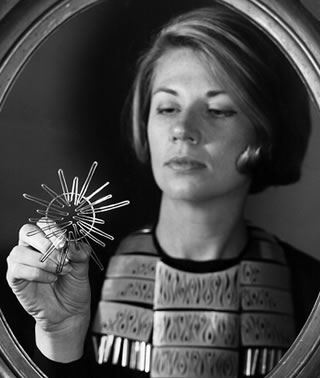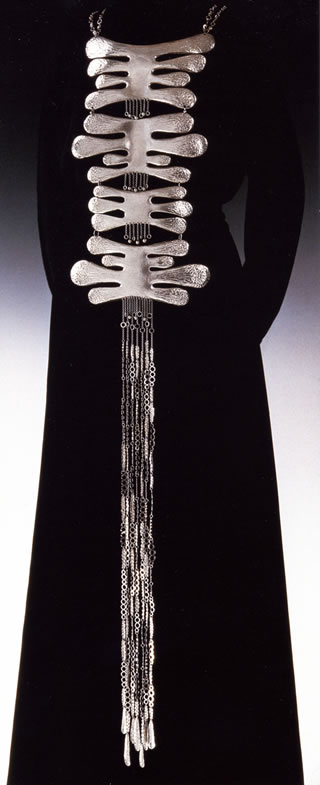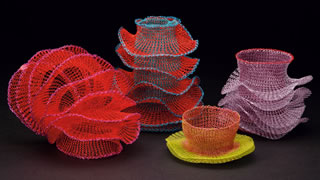The Body Beautiful - Page 3
Fisch, who founded the jewelry department at San Diego State and spent most of her career there, has studied and taught worldwide, won multiple Fulbright grants and other awards, and been named a ‘California Living Treasure.’ Her work is in many museums, including the Victoria and Albert, the Boston Museum of Fine Arts, and the Vatican.
Fisch works with ordinary materials like glass beads, with metal and with semi-precious stones—but rarely with diamonds. “Precious stones I find so compelling I can’t submerge them into what I’m trying to do,” she says.
She also avoids making rings. “They’re too small to have a major impact and they’re a little more fussy to make.”
By far the works Fisch is best known for are her metal textile pieces—body ornaments, sometime voluminous, constructed by weaving, crocheting, pleating, and similar techniques. It was a technique she introduced to fine art jewelers. Like her move into jewelry itself, this came almost by accident.
As Fisch recounted in her oral history, as a student living in “a little bed sitter in the middle of London,” she wanted to work on something there, when she was home from the studio. With woven metal, she discovered, “I could make the components at the workshop, and then I could work on it in my room.”
“Moving into the textile structures, there’s also a big jump,” Fisch said in her oral history, “because it meant that work could be flexible and soft. That whole idea that metal could be soft was a concept that was new to me and was exciting to pursue in all kinds of ways.”
Fisch has compared people who wear her work to “birds with beautiful feathers.”
 |
|
|
 |
|
|
 |
|
|
Unlike Fisch, who earned her living teaching, Renk taught only briefly. Instead she made a living by producing art, working in a loft studio in the compact hillside home in the city she shared with her husband Earle Curtis, a potter, and two daughters.
It helped that the house, which cost only $7,800 when they bought it in 1959, was quickly paid off. Their lifestyle also helped. “If we can sell enough work to take care of our families,” she recalls, “that’s enough. And we live more simply.”
Renk still lives in the same home, an early 20th century cottage that was given a mid-century modern interior by her close friend and next-door neighbor, architect Albert Lanier. One of Renk’s daughters lives downstairs in her late husband’s former studio. The jewelry studio in her loft is still equipped with tools and grinders, and with display tables built by Art Espenet Carpenter, the well known furniture maker, another friend.
Unlike Fisch, Renk was happy to work on commission—and she would make rings. Hers were often quite unusual; some had ‘rolling pearls’ that moved.
Renk is known for her golden crowns—both daughters wore them during their weddings—and for intricate, often large pieces made up of repeated or interlocking forms, often of folded metals or of V-forms.
One notable piece, very mid-century in theme and owned by the Boston Museum of Fine Arts, is a silver and red enamel necklace from 1954 that appears to be a string of atomic nuclei.
“What’s most unique about her work is her meticulous shapes, her precise, clean lines,” Cooper says, adding, “She is more painterly in a way [than other jewelers], and has ended up painting and drawing.” Unlike most jewelers of her day, Cooper says, Renk often worked in color.
Renk also reinvented and popularized a technique for plique-a-jour enamelwork—using enameling (melted glass) to create what were in effect tiny, stained glass windows within her wearable art.
“They’re beautiful,” Cooper says. “They’re beautifully designed, and then you have these elements of color coming out of them. They’re organic forms; they’re kind of growing.”




